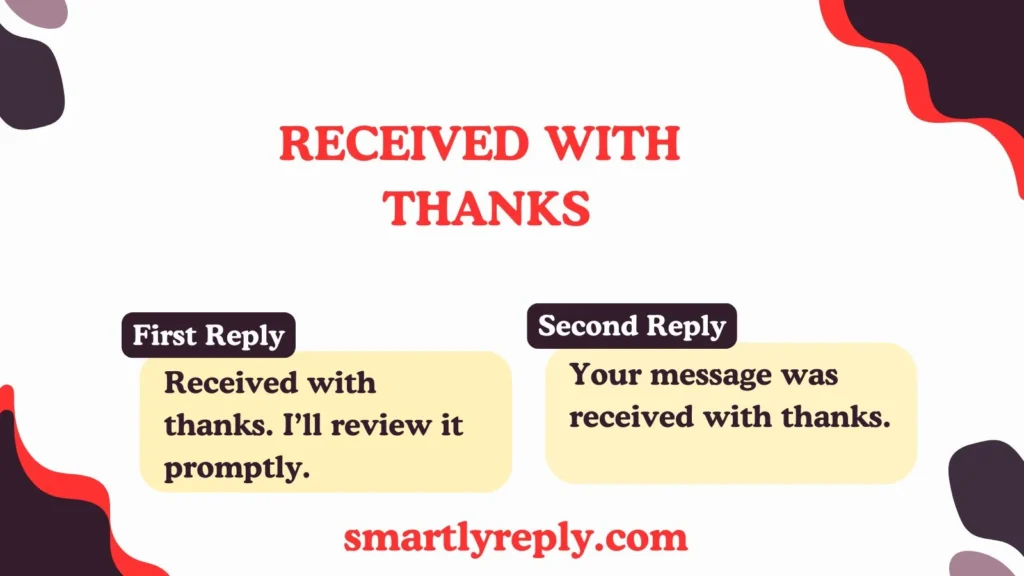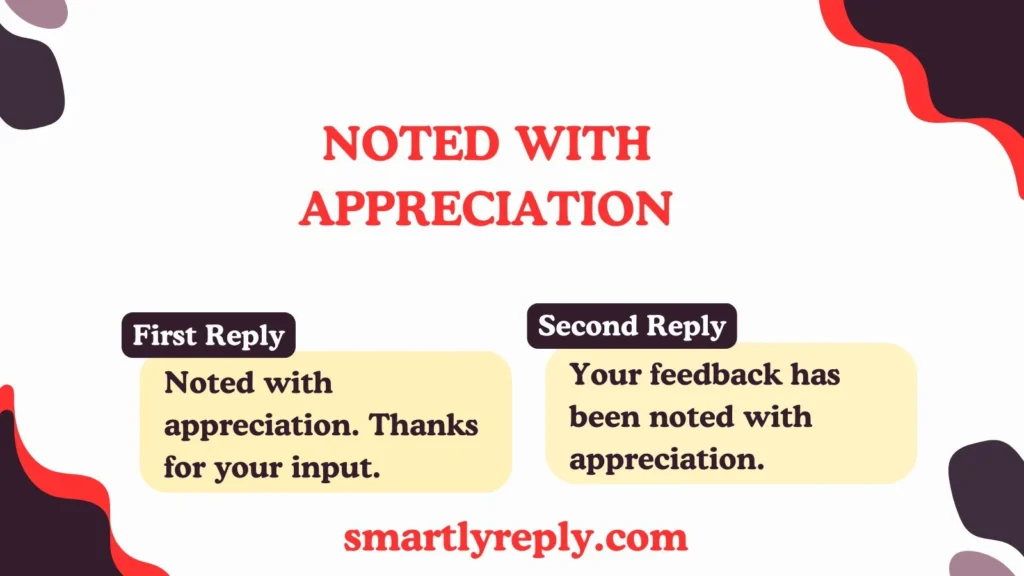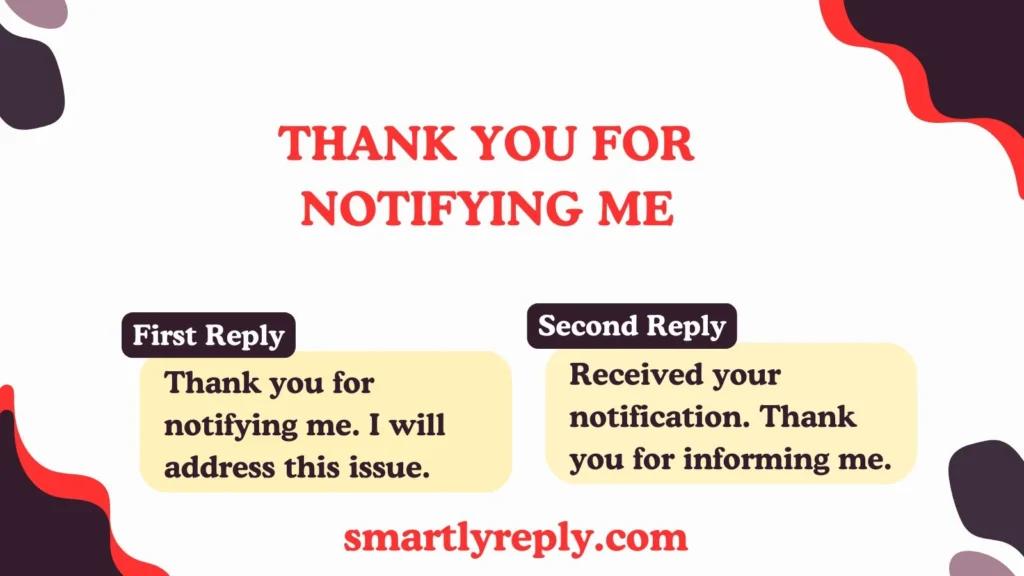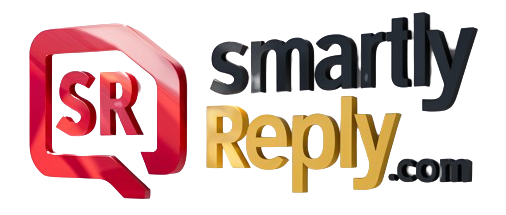Last Updated on December 1, 2024 by
When acknowledging receipt or understanding of information in an email, you can use various phrases to convey that you’ve taken note of the details.
Looking to add variety to your emails? Instead of the usual “Well Noted,” try alternatives like “Understood,” “Acknowledged,” or “Thanks for the update” to sound more engaging and professional. These options help you convey tone, build rapport, and enhance clarity in your communication.
Here are 20 alternatives to “well noted,” complete with definitions, scenarios, and examples to help you communicate effectively.
1. “Acknowledged”
Definition: Confirming that the information has been received and understood.
Scenario: After receiving instructions.
- Example 1: “Acknowledged. I’ll proceed as discussed.”
- Example 2: “Your feedback has been acknowledged. Thank you.”
If you’re in the mood for a laugh and want to read a Joke and Puns, click on Punsterz.com 😂. You’ll laugh so hard your cheeks will turn red!
2. “Noted”
Definition: Indicating that the information has been taken into account.
Scenario: Following up on a request or detail.
- Example 1: “Noted. I’ll make the necessary adjustments.”
- Example 2: “Thank you for the update; noted.”
Also Read : Birthday Countdown Quotes
3. “Received with Thanks”

Definition: Confirming receipt and showing appreciation for the information.
Scenario: After receiving important documents or details.
- Example 1: “Received with thanks. I’ll review it promptly.”
- Example 2: “Your message was received with thanks.”
If you’re in the mood for a laugh and want to read a joke, click on this Punnz.com 😂. You’ll laugh so hard your cheeks will turn red!
4. “Understood”
Definition: Confirming that the information has been comprehended.
Scenario: After clarification or instructions are provided.
- Example 1: “Understood. I’ll follow the guidelines.”
- Example 2: “Your instructions are understood. Thank you.”
🔥 Get ready to impress with smooth reply at Replyswift.com! Whether you’re looking for cool pickup lines or clever responses, we’ve got the perfect phrases to spark a connection. Make your conversations stand out today! 😎💬
5. “Thank You for the Information”
Definition: Acknowledging receipt of information with thanks.
Scenario: After receiving details or updates.
- Example 1: “Thank you for the information. I’ll get back to you shortly.”
- Example 2: “Received your update. Thank you for the information.”
6. “Got It”
Definition: Informal way of acknowledging receipt and understanding.
Scenario: After receiving quick updates or instructions.
- Example 1: “Got it. I’ll handle it accordingly.”
- Example 2: “Thanks for the update. Got it.”
If you’re feeling troubled by life’s circumstances and want to encourage yourself with uplifting quotes, 🌟 Quotebrella.com
7. “I Appreciate the Update”
Definition: Showing gratitude for receiving the information.
Scenario: After receiving a status update.
- Example 1: “I appreciate the update. Will proceed as advised.”
- Example 2: “Thanks for the detailed update. I appreciate it.”
8. “Duly Noted”
Definition: A formal way of acknowledging and recording information.
Scenario: After receiving formal correspondence.
If someone isn’t feeling inspired by you, visit this Talkslikeme.com. It has such an impressive style that anyone – whether a girl or a boy – will be impressed by you. Keep smiling!
- Example 1: “Duly noted. I will take the necessary actions.”
- Example 2: “Your points have been duly noted. Thank you.”
9. “Noted with Appreciation”

Definition: Acknowledging the information and expressing gratitude.
Scenario: After receiving helpful feedback.
- Example 1: “Noted with appreciation. Thanks for your input.”
- Example 2: “Your feedback has been noted with appreciation.”
10. “Acknowledgement Received”
Definition: Confirming that the information has been acknowledged.
Scenario: After receiving an important message.
- Example 1: “Acknowledgement received. I will review the details.”
- Example 2: “Thank you for sending the documents. Acknowledgement received.”
Looking for the perfect response? Visit our Smartly Reply homepage for expert answers to every situation!
Read more and level up your replies Smartly Reply
11. “I Have Taken Note of This”
Definition: Confirming that the details have been noted.
Scenario: After receiving detailed instructions.
- Example 1: “I have taken note of this and will act accordingly.”
- Example 2: “Thanks for the clarification. I have taken note of it.”
12. “Message Received”
Definition: Informally acknowledging that the message has been received.
Scenario: After a brief or casual update.
- Example 1: “Message received. I’ll follow up soon.”
- Example 2: “Thanks for the update. Message received.”
🔥 Get ready to impress with smooth rizz at RizzLinez.com! Whether you’re looking for cool pickup lines or clever responses, we’ve got the perfect phrases to spark a connection. Make your conversations stand out today! 😎💬
13. “I’ve Registered This Information”
Definition: Confirming that the information has been recorded.
Scenario: After receiving important updates.
- Example 1: “I’ve registered this information. Thanks for the details.”
- Example 2: “Your message has been registered. I’ll review it.”
14. “Noted and Actioned”
Definition: Indicating that the information has been noted and will be acted upon.
Scenario: After receiving instructions for a task.
- Example 1: “Noted and actioned. I’ll get started on it.”
- Example 2: “Thanks for the instructions. Noted and actioned.”
🖍️ Looking for fun drawing activities for your kids? Visit KidzDrawing.com! Perfect for kids of all ages! 🎨🌟
15. “Received and Recorded”
Definition: Confirming that the information has been received and documented.
Scenario: After receiving detailed reports or data.
- Example 1: “Received and recorded. I’ll process the information.”
- Example 2: “Your report has been received and recorded.”
16. “Thank You for Notifying Me”

Definition: Expressing gratitude for providing the information.
Scenario: After receiving a notification or alert.
- Example 1: “Thank you for notifying me. I will address this issue.”
- Example 2: “Received your notification. Thank you for informing me.”
If you want to flirt with someone and impress them, visit Wittyrizz.com ❤️your problem will be solved!
17. “Confirmed”
Definition: Acknowledging that the information has been confirmed and understood.
Scenario: After confirming details or instructions.
- Example 1: “Confirmed. I’ll proceed as directed.”
- Example 2: “Your request has been confirmed. Thanks for the info.”
😂 Get ready to laugh out loud at HaHapuns.com! Explore a vast collection of jokes and clever puns designed to make you smile. Whether you’re looking to lighten the mood or share a laugh with friends, we’ve got the perfect humor for you! 🌟🎊
18. “Received and Acknowledged”
Definition: Confirming both receipt and acknowledgment of the information.
Scenario: After receiving an important communication.
- Example 1: “Received and acknowledged. I’ll get back to you shortly.”
- Example 2: “Thank you for the update. Received and acknowledged.”
19. “Information Received”
Definition: Indicating that the information has been received.
Scenario: After receiving details for a project.
- Example 1: “Information received. I will review it soon.”
- Example 2: “Thank you for sending the information. Received.”
If you’re on a date with someone and both of you are silent, here’s how to break the silence and impress your partner. visit Pickup Line.
20. “Acknowledgment Noted”
Definition: Confirming that acknowledgment of the information has been noted.
Scenario: After receiving a formal update.
- Example 1: “Acknowledgment noted. I’ll take the necessary actions.”
- Example 2: “Your email has been acknowledged and noted.”
If you have a pet but are struggling to find a name, click on Petsnamez.com—your problem will be solved
FAQs
1. Why should I use alternatives to “Well Noted” in emails?
Using alternatives to “Well Noted” keeps your emails engaging and helps convey specific tones, such as enthusiasm, professionalism, or acknowledgment. This variation can improve clarity and show attentiveness to different situations.
Facing difficulty with English word comparisons? No need to worry—just click Talkspeaker.com, and your grammar resolved easily!
2. What are some formal alternatives to “Well Noted”?
Formal alternatives include phrases like “Acknowledged with thanks,” “Duly noted,” or “I have taken note of this.” These phrases sound polite and professional, making them ideal for workplace emails.
3. How can I convey acknowledgment in a friendly tone?
To keep it friendly, try options like “Got it, thanks!” or “Thanks for the heads-up!” These alternatives feel approachable while still showing you’ve understood the message.
4. Are there alternatives to “Well Noted” for follow-up emails?
Yes! For follow-ups, consider “I’ll keep this in mind,” or “This will be considered moving forward.” These options show you’re proactive and ready to act on the information.
5. How can using varied responses improve my email communication?
Switching up phrases keeps communication fresh and reflects attention to detail, helping you make a strong impression on colleagues and clients. It also demonstrates language versatility, which can enhance clarity and engagement.
Conclusion
In conclusion, there are plenty of alternatives to saying “Well noted” in an email, each adding a touch of variety and professionalism to your communications. Phrases like “Understood,” “Acknowledged,” or “Message received” can convey that you’ve grasped the details without sounding repetitive.
Using alternatives helps you show attentiveness and adjust your tone to suit the context—whether formal, friendly, or collaborative. These small changes make a big impact in showing respect, engaging your reader, and keeping your emails clear and memorable.


